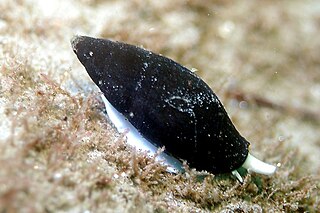
Mussel is the common name used for members of several families of bivalve molluscs, from saltwater and freshwater habitats. These groups have in common a shell whose outline is elongated and asymmetrical compared with other edible clams, which are often more or less rounded or oval.

The blue mussel, also known as the common mussel, is a medium-sized edible marine bivalve mollusc in the family Mytilidae, the mussels. Blue mussels are subject to commercial use and intensive aquaculture. A species with a large range, empty shells are commonly found on beaches around the world.

Ark clam is the common name for a family of small to large-sized saltwater clams or marine bivalve molluscs in the family Arcidae. Ark clams vary both in shape and size. They number about 200 species worldwide.

Rapana venosa, common name the veined rapa whelk or Asian rapa whelk, is a species of large predatory sea snail, a marine gastropod mollusc or whelk, in the family Muricidae, the rock shells.

Barbatia is a genus of "bearded" ark clams, marine bivalve mollusks in the family Arcidae, the ark clams.

Dicathais is a genus of predatory sea snails, marine gastropod molluscs in the family Muricidae, the rock snails. This genus is monotypic; the only species in it is Dicathais orbita, common name the white rock shell or cart-rut shell, found round the coasts of Australia and New Zealand.

Mytilus is a cosmopolitan genus of medium to large-sized edible, mainly saltwater mussels, marine bivalve molluscs in the family Mytilidae.

Ostrea lurida, common name the Olympia oyster, after Olympia, Washington in the Puget Sound area, is a species of edible oyster, a marine bivalve mollusk in the family Ostreidae. This species occurs on the northern Pacific coast of North America. Over the years the role of this edible species of oyster has been partly displaced by the cultivation of non-native edible oyster species.

Calliostoma ligatum, common name the blue top snail, is a small prosobranch trochid gastropod mollusk in the family Calliostomatidae, the Calliostoma top snails.

Atrimitra idae, common name Ida's miter, is a species of medium-sized sea snail, a marine gastropod mollusk in the family Mitridae, the miters.

The marine snail Norrisia norrisii is a medium-sized gastropod mollusk within the family Tegulidae. It has several common names, including Norris's top snail, Norris's topsnail, norrissnail, smooth brown turban snail, or kelp snail. It was first described by G.B. Sowerby I under the name Trochiscus norrisii.

Conus xanthicus, common name the Guaymas cone, is a species of sea snail, a marine gastropod mollusk in the family Conidae, the cone snails and their allies.

Cyrtopleura costata, or the angel wing clam, is a bivalve mollusc in the family Pholadidae. It is found in shallow parts of the northwest Atlantic and also in the North Sea of Scotland coastline and west coast of the Adriatic Sea by a remote area in the Marche region in central Italy, living in the seabed, where it digs its burrows on a very slow revolving movement for years through soft sand and mud always to a max depth of 8ft but always below 3 feet (0.91 m) at the lowest tide.

Barbatia barbata is a species of ark clam, a marine bivalve mollusk in the family Arcidae, the ark clams.
Potamocorbula amurensis is a species of small saltwater clam, a marine bivalve mollusc in the order Myida. Common names include the overbite clam, the Asian clam, the Amur River clam and the brackish-water corbula. The species is native to marine and brackish waters in the northern Pacific Ocean, its range extending from Siberia to China, Korea and Japan. It has become naturalised in San Francisco Bay.

Pinctada mazatlanica is a species of tropical marine bivalve mollusc in the family Pteriidae, the pearl oysters. It is known by the English common names pearl oyster, Mazatlan pearl oyster, and Panama pearl oyster. Spanish common names include madre perla, and ostra perlifera panameña. This mollusc was first described to science in 1856 by conchologist Sylvannus Charles Thorp Hanley. Pinctada mazatlanica produces gem-quality pearls and was the basis of a pearling industry in the Gulf of California for centuries.

Mytella charruana is a bivalve, commonly known as the charru mussel. This species was discovered in Central and South America and by Alcide d’Orbigny, A French naturalist in 1842. They are less than an inch long, and range from brown to black in color.

Modiolus capax, common name fat horsemussel, is a species of "horse mussel", a marine bivalve mollusc in the family Mytilidae, the mussels. It was first described to science by American malacologist Timothy Abbott Conrad in 1837. The type specimen was collected in San Diego by Thomas Nuttall.

Lirabuccinum dirum, commonly known as the dire whelk, the spindle shell or the spindle whelk, is a species of sea snail, a marine gastropod mollusk in the family Buccinidae, the true whelks. It used to be known as Searlesia dira and Buccinum dirum before being transferred to the genus Lirabuccinum.

Carditamera affinis is a species of marine bivalve mollusc. It was first described to science by George Brettingham Sowerby I in 1833. No English common name has been recorded for this species. The first appearance of this animal in the fossil record is 5.333 million years ago.


















